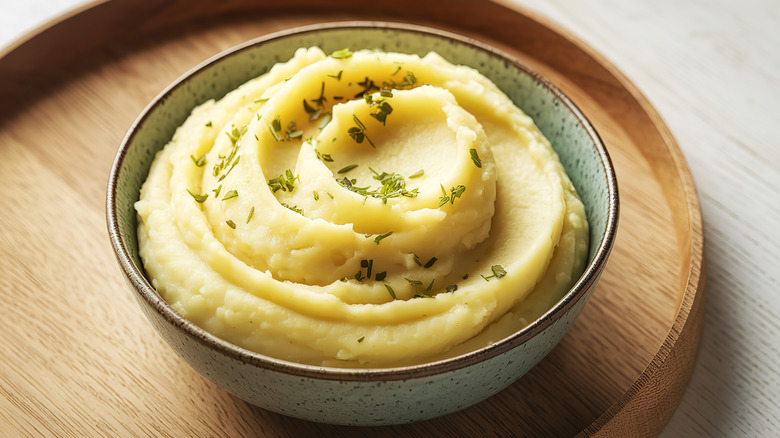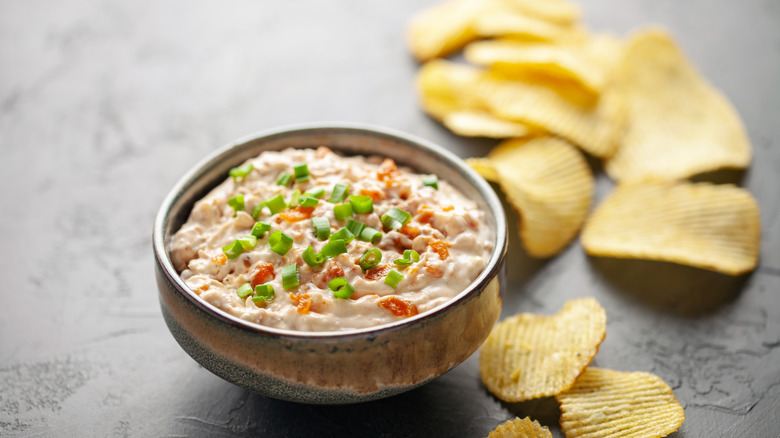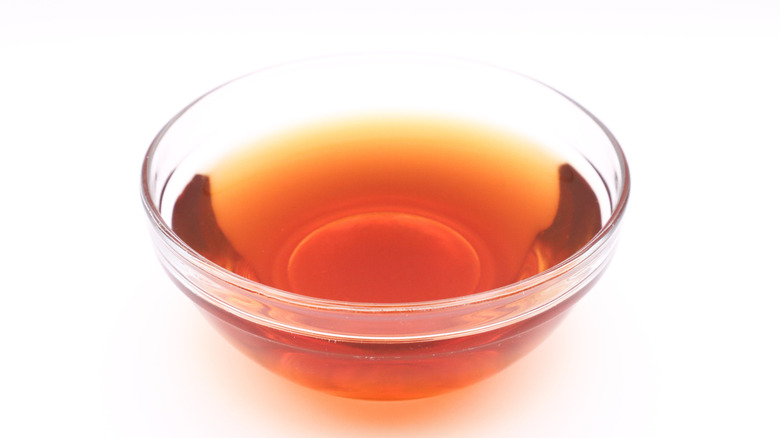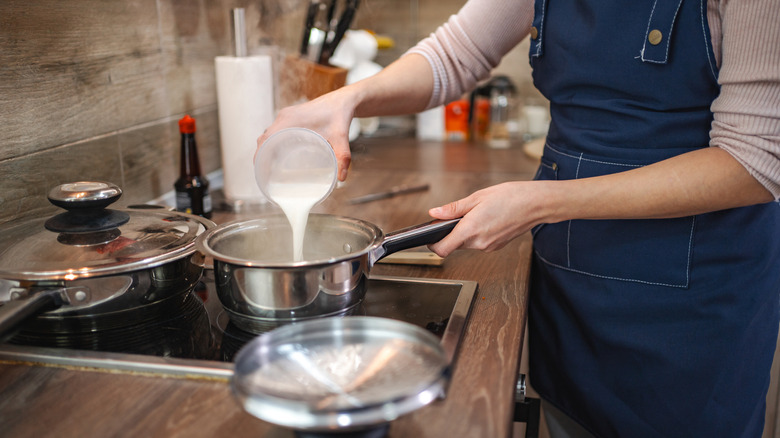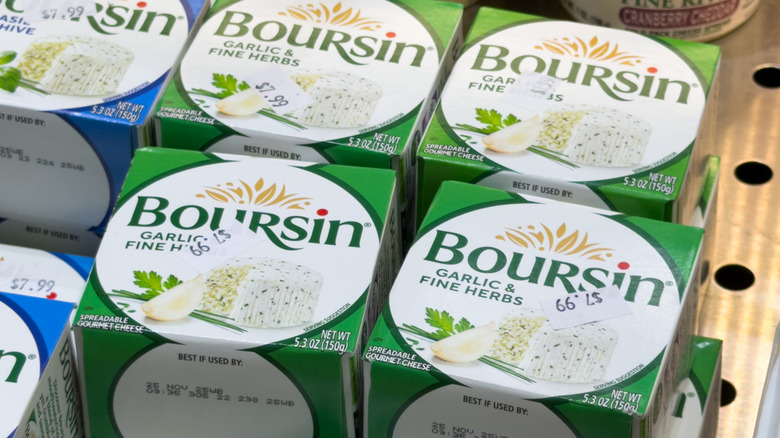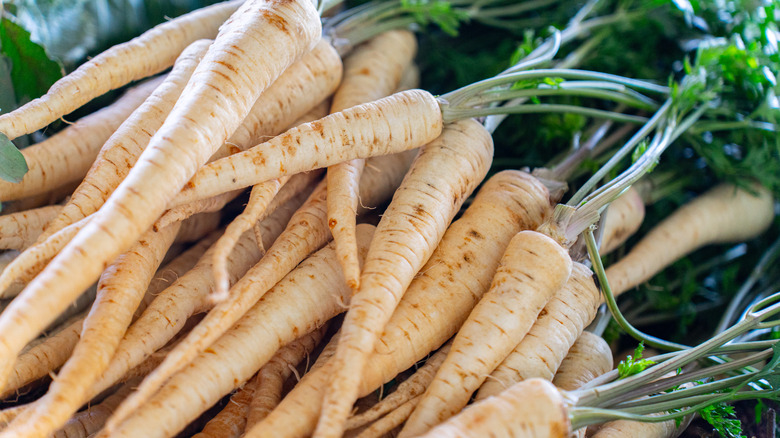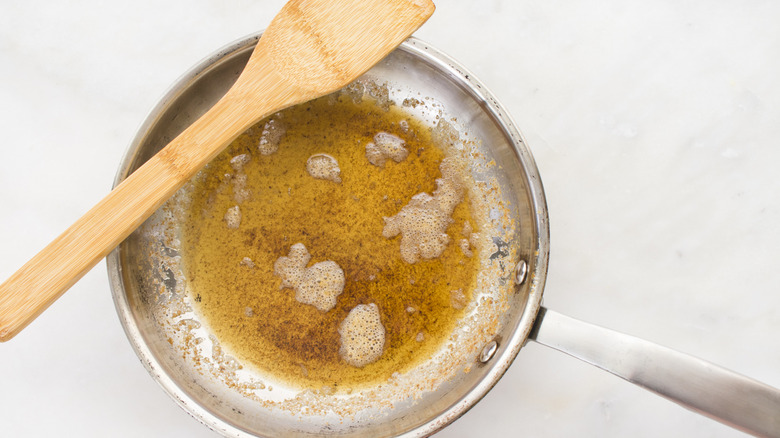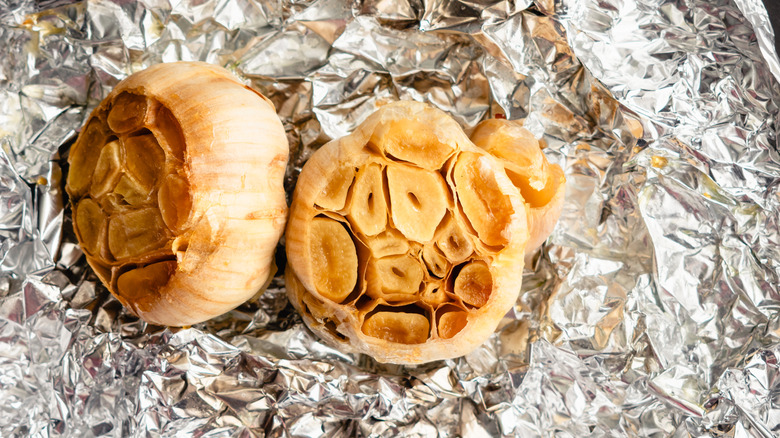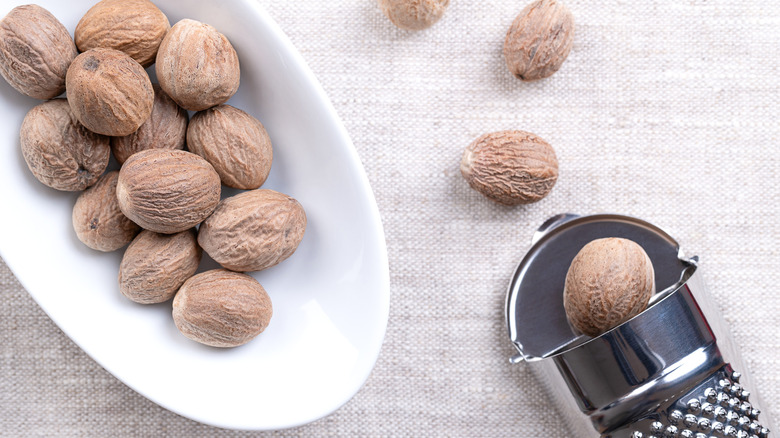14 Ingredients You Need To Start Adding To Your Mashed Potatoes
Mashed potatoes are, at their core, utterly simple. Spuds, butter, milk, salt, pepper. Yet, despite their simplicity (or maybe because of it), they're frequently the star of the show at many a holiday gathering. They're the perfect starchy side to soak up an array of sauces, whether you're just topping them with gravy or you're using them as a base for goulash, beef stroganoff, or a number of other hearty, comforting dishes.
However, if you've mastered the basics of a good bowl of mashed potatoes (because, even as easy as they seem, there are a lot of mistakes you can make with mashed potatoes), you may be hungering for something more. You might want to take those tubers to the next level. Jazz up the flavor profile. Give the texture a little 'oomph.' If that sounds like you, these are the ingredients that you need to start adding to your mashed potatoes, stat.
Whipped cream
Okay, hear us out here before you turn up your nose. We're not talking about the sugary tub of Cool Whip that might be lingering in your freezer right now. We're talking from-scratch, plain, un-sugary whipped cream. Yes, making whipped cream from scratch is an extra step in the process, but whipped cream is the unexpected ingredient you need for fluffier mashed potatoes.
All you have to do is beat cold heavy cream in a stand mixer until stiff peaks form. Then, bit by bit, gently fold the whipped cream into your mashed potatoes in place of your normal milk (still keep the butter).
It's a hack that takes root in the French dish, pommes de terre Chantilly, or Chantilly potatoes. Chantilly cream is just whipped cream, so "pommes de terre Chantilly" translates to "potatoes of whipped cream." However, for the French version of this dish, you'd go a step further, after adding your whipped cream to the mashed potatoes. You'd also smooth the mashed potatoes into a baking dish, top them with cheese, and bake them until bubbly and golden brown.
Chip dip
French onion dip is a staple in any party spread and it's likely one of the first snacks to be obliterated by hungry party-goers, despite the risk of a somewhat fragrant breath throughout the rest of the evening. Take those crave-able flavors and expand their usefulness, by incorporating French onion dip mix into your mashed potatoes. You won't need to add the whole pack of dip mix (though nothing's stopping you if you really want to) and, don't worry, the dehydrated onions in the mix will become softer as you combine them with your hot potatoes.
But why stop there? Blend the best of both worlds and make a mashed potato chip dip, using your leftovers (if you have any). Leftover mashed potatoes meet some stock to thin them out and create a dip-able mixture. Add the richness of sour cream and cheese, and you get a mashed potato dip that goes perfectly with kettle-cooked potato chips.
Vinegar
Maybe you like to toss a little malt vinegar onto your french fries. Maybe you can't resist the siren song of a bag of salt and vinegar potato chips. Whatever the case, vinegar and potatoes are a match made in heaven — so why aren't we adding vinegar to our mashed potatoes? With just one ingredient, you can make mashed potatoes taste like salt and vinegar potato chips.
After you mix in your butter and milk, toss in a splash of vinegar, tasting as you go to ensure you don't add too much and overwhelm the buttery richness of the potatoes themselves. Start with just a few teaspoons. The first time you make salt-and-vinegar mashed potatoes, reach for the malt vinegar, for the most familiar flavor profile. However, after that, explore further afield, with all the other different, amazing vinegars at your disposal. Balsamic vinegar is another popular option (particularly if you're incorporating some garlic into the mashed potatoes, too), but white wine vinegar will also work, as will rice vinegar.
Infused milk
Rather than add an extra ingredient to your typical mashed potato formula of potatoes, milk, butter, and seasonings, why not upgrade one of these staples in a new, creative way? Rather than reaching for your ho-hum, plain ol' milk, give that milk an impressive, somewhat fancy makeover, by infusing it with extra flavor. It's one of the top chef-approved tips for making the best mashed potatoes, hands-down.
All you need to do to infuse milk is heat the milk on the stovetop alongside whatever herbs, spices, or seasonings that you want to infuse the milk with. You can do this while you're cooking your potatoes, so that the milk and spuds are ready to combine at the same time. So what should you actually add to your milk? Options include peppercorns, nutmeg, or a bouquet garni, which is just a fancy French term for bay leaf, thyme, and parsley, tied together with twine.
You can also use a leftover parmesan rind to infuse milk. Leftover parmesan rinds come in handy in a variety of recipes, as a simple flavor booster (in fact, Ina Garten uses them in her soups to provide flavor, similar to how you might toss in a bay leaf), so be sure to hold onto yours. You can store them in the freezer, in an airtight bag, until you're ready to use them — almost indefinitely.
Coffee creamer
So you want to make some mashed potatoes. Maybe you've even been tasked with making this side dish for a holiday gathering. But you've been so busy lately, you haven't made it to the grocery store. You think you have everything on hand to whip up some mashed potatoes ... but then when your spuds are on the stove, you take a look in the fridge and realize you're out of one seemingly crucial ingredient: milk.
Before you get desperate and add water to your mashed potatoes (ick!), take a look around your kitchen for what other ingredients you could use instead. Unsweetened coffee creamer can easily take the place of milk in your mashed potatoes. You'll find that you can't even really tell the difference. Just make sure that your coffee creamer is unsweetened and unflavored before you add it. No one (probably) wants a peppermint mocha mash, or a pumpkin spice potato dish.
Boursin
If you don't always have some Boursin cheese at the ready in your fridge, you're missing out. This delicious ingredient can add creamy, flavorful goodness to a variety of dishes, from pastas to casseroles — and it's the secret ingredient to amazing Thanksgiving mashed potatoes. Literally all you have to do is make your mashed potatoes like normal (just leaving out any other creamy, cheesy ingredients you might normally include, like sour cream or cheddar cheese) and then toss in your preferred flavor of Boursin. You'll need about one package of Boursin cheese for every four large potatoes in your mash.
If you're not familiar with Boursin cheese, it's a widely available and specific brand of French Gournay cheese that's easily spreadable, comes in a small wheel, and is available in a variety of different flavors. Prefer to rely on store-bought products as little as possible if you can make an ingredient yourself? You can actually make your own Boursin cheese at home, using cream cheese and seasonings.
Celery root
Sometimes, it's not the case that you need to add more ingredients to your mashed potatoes to upgrade them, but, instead, you need to swap out some of the potatoes with something else: like celery root, also known as celeriac. The late Anne Burrell used this root veggie to elevate her mashed potato recipe, as it adds a vegetal refinement to an otherwise rich and heavy bowl of mashed potatoes.
Celery root, though, admittedly, isn't as commonplace in most kitchens as potatoes. If this vegetable doesn't make your grocery list all that often, you may be intimidated by its knobby, somewhat ugly exterior. However, all you have to do is cut off the tops and bottoms (including any greens), and then wash and peel the roots. From there, you can basically use it like any root vegetable. For incorporating celery root into your mashed potato recipe, just cube and cook it along with your potatoes. Use celery root and potatoes in equal amounts. Once cooked, drain the two veggies and pass them through a food mill before adding your other desired ingredients.
Cream cheese
If messing with your normal mashed potato recipe makes you a little nervous, one of the simplest upgrades you can make is adding cream cheese to your mashed potatoes. It won't create an entirely new flavor profile, but it will add creaminess and richness. Plus, you likely already have some on hand, especially if you're making mashed potatoes mid-holiday season.
You won't need too much cream cheese for most mashed potato recipes, unless you're making a huge quantity. If you're making 15 pounds of potatoes (which is about enough to feed 20 people, so the whole fam, plus some), you'll need the entire block of cream cheese. Otherwise, adjust the amount you use from there. Additionally, make sure that the cream cheese is at room temperature when you add it to your mashed potatoes, to avoid ending up with a bunch of cream cheese lumps throughout your mash.
Mayonnaise
It's one of the top ways to use mayonnaise that you need to try ASAP – yes, really! Mayonnaise makes for a creamy bowl of mashed potatoes and, no, the potatoes do not end up tasting like mayo. Additionally, adding mayonnaise to your mashed potatoes if you plan on serving them later comes with an extra bonus. If you've ever refrigerated mashed potatoes, you've likely noticed that they harden up after a while in the cold. This is because the butter solidifies. If you replace some of that butter with mayonnaise, though, the potatoes don't harden up quite as much. so reheating them becomes easier and you end up with a product that's closer to what you started with. So, if you're making dishes in advance, add some mayo to your mashed potatoes.
Plus, in a pinch, you can even use mayonnaise in place of milk and butter entirely in your mashed potatoes. While this may mean that your mashed potatoes won't taste entirely the same, due to that lack of buttery goodness, you will still get a velvety, creamy texture, thanks to the mayo's oil content.
Parsnips
Similarly to adding celeriac to your mashed potatoes, parsnips can likewise take the place of a portion of your spuds, for upgraded mashed potatoes. They'll deliver a slightly sweet, earthy flavor that your guests likely won't be able to guess (perfect if you love stumping family and friends with your use of special secret ingredients).
When adding parsnips to your mashed potatoes, aim for one-third parsnips, two-thirds potatoes. You can boil or roast your parsnips, before adding them to your cooked potatoes and mashing like normal. If you love the results, you might even consider axing the potatoes completely and serving mashed parsnips in the future instead. Without the potatoes, the mash will have more of that sweet, nutty parsnip flavor, but the texture will be pretty much the same. If you have any parsnips leftover, there are plenty of other great ways to use this vegetable, too, including in soups and stews, roasted or braised, anywhere you might normally use a root vegetable like a carrot or potato, or even in your holiday turkey stuffing.
Brown butter
We've talked ways to upgrade the potatoes in your mashed potatoes. We've talked ways to upgrade the milk in your mashed potatoes. Now it's time to upgrade that butter. Browning the butter that you use in your mash will result in a nutty, distinguished flavor profile that feels elevated beyond your typical side dish.
Making brown butter isn't terribly difficult, but once you master it, you'll find yourself using it in just about everything. All you need to do is melt your unsalted butter on the stovetop, slowly, over medium-low heat. You'll have to watch it, gently stirring. When the melted butter goes from golden yellow to light brown, turn off the heat and continue stirring, until the butter turns just a bit darker. At this point you'll add a tablespoon of cold butter to the pan to bring down the temperature, preventing the butter's milk solids from burning. Once you're done, you can use brown butter to elevate the flavors of everything from mashed potatoes to baked goods, pasta to roasted veg.
Kale
When you think mashed potatoes, you probably think decadent, delicious, hearty, warming, soul-soothing ... but maybe not healthy. So, give your mashed potatoes a slightly healthful slant by adding some kale to the mix.
Combining mashed potatoes and kale is nothing new. It wasn't something born from the kale craze of the early 2010s. Instead, this dish can be traced back to 1700s Ireland, where it gained the name "colcannon." While a staple part of the Irish diet at the time, it was also a traditional Halloween dish, and tradition stated that one should hide various trinkets inside the potatoes. Whatever trinket that diners received in their spuds would predict their fortune for the coming year. For example, if you found a coin in the potatoes, wealth was coming your way. (Nowadays, maybe don't hide any foreign objects in your mashed potatoes before serving them, if you want to avoid a potential trip to the dentist or even the ER.)
Roasted garlic
Many mashed potato recipes will tell you to add garlic salt or seasoning to the mix, which is perfectly fine, but why not actually go through the process of roasting your garlic for your mashed potatoes, for a fresher, bolder flavor? Roasting garlic will take some extra time, but it incredibly easy. Just combine a head of garlic with some olive oil and wrap it up into a tight ball of aluminum foil. Then, toss the ball into the oven to bake for about an hour. The cloves come out nice and soft, and you can easily remove them and add them to your mashed potatoes.
If the roasted garlic is a bit too pungent for your liking, you might consider making garlic confit for your mashed potatoes instead. The flavor is a little sweeter and subtler. To make garlic confit, simmer peeled garlic cloves in olive oil, for about half an hour. Then, mash the garlic into a paste before adding to your mashed potatoes.
Nutmeg
Reach into your spice cabinet for this mashed potato upgrade. Nutmeg is an unexpected ingredient that can really take your mashed potatoes to the next level, with a warm, nutty spiciness that adds flavorful intrigue to savory dishes, even though nutmeg is more so associated with holiday baking and sweets. Additionally, it can make your mashed potatoes stand out from the other buttery, cheesy, rich, and starchy side dishes you may be serving at the same time.
You'll only want to add a scant amount of nutmeg to your mashed potatoes, at the same time that you add your salt and pepper. A pinch or so is plenty enough, whether you use freshly grated nutmeg or pre-ground nutmeg from the store. Then, if you try this hack and decide you like the results, you might add further spices in the form of quatre épices, a French blend of four spices including white pepper, ginger, nutmeg, and cloves. Also consider expanding your use of nutmeg to other savory foods, too. It works very well in macaroni and cheese, as well as in lasagna.
